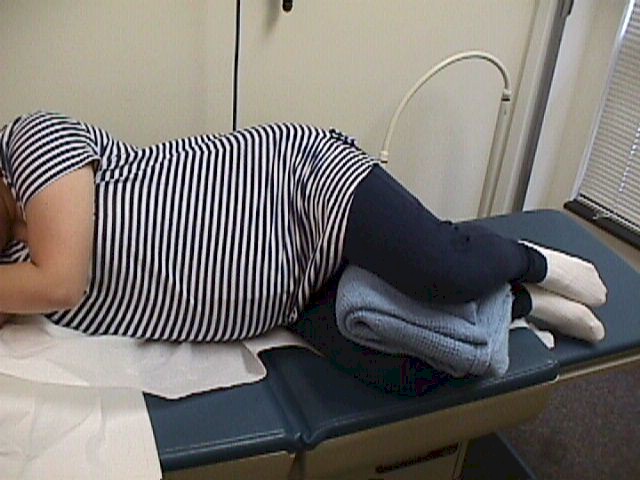|
Sometimes, the patient's condition is such that her medical needs are
best served through transfer from an isolated area to support center where
more complete medical resources are available. This is called a "medical
evacuation" or MEDEVAC.
 Medical evacuation of a woman with a gynecologic problem is usually
straightforward. Transporting of a pregnant woman, however, bears special
consideration. The primary issues are: Medical evacuation of a woman with a gynecologic problem is usually
straightforward. Transporting of a pregnant woman, however, bears special
consideration. The primary issues are:
Special Positioning
Non-ambulatory, non-pregnant patients are generally transported on their
back. This facilitates safe positioning on the litter and allows easy access
to the patient for monitoring and airway control.
In the pregnant patient, lying flat on her back has two effects, both of them bad:
-
In this position, uterine blood flow is reduced, sometimes enough to
compromise the fetus, and
-
The heavy uterus compresses the inferior vena cava, trapping blood in
the lower extremities and compromising maternal cardiac output.
To avoid these problems, it is best to transport the pregnant woman (in the second and third trimester) on her side, with both knees flexed, with a small pillow between the knees. Safety straps can be easily attached with her in this position, and monitoring is not compromised. She can be
positioned on either her left or right side, but may need to move from one side to the other.
 Some pregnant women cannot be transported in this way for other
reasons...she may be in a backboard or have casts on her limbs that prohibit
this positioning. In such cases, the uterus can still be moved off the
inferior vena cava: Some pregnant women cannot be transported in this way for other
reasons...she may be in a backboard or have casts on her limbs that prohibit
this positioning. In such cases, the uterus can still be moved off the
inferior vena cava:
-
With the palm of your hand, or with a fist, push the uterus toward the
patient's right side (push from left to right). This will displace the
uterus enough to restore normal blood flow both to the patient's heart and
to the fetus. The drawback to this approach is that although it is
effective, it requires an extra pair of hands to constantly keep the
uterus off to the patient's right side.
-
Place a small pillow, rolled up towel, or blanket under the patient's
left hip. This 4 inch elevation of the left hip will be sufficient to
displace the uterus from the inferior vena cava.
Risk of Labor or Delivery
Unexpected labor or delivery while in transit is more difficult to deal with (and more
dangerous) than the same problem occurring in a stable environment. When
someone is transported who is in labor, a qualified medical attendant needs
to accompany her so that delivery, should it unexpectedly occur, will be the
safest that can be provided under the circumstances.
Risk
of Rapid Deterioration of Condition
One feature of pregnancy is a tendency for women thought to be doing well,
to rapidly deteriorate:
-
Hemorrhage. Pregnant women who are not bleeding can
experience a sudden placental abruption, associated with torrential hemorrhage.
Within minutes, they can lose half their blood volume. Women who have just
delivered are also subject to such sudden onset of life-threatening
bleeding. Pregnant women who have demonstrated any vaginal bleeding should
be transported with an IV line in place.
-
Shock. The non-pregnant individual who sustains on-going blood loss
will usually demonstrate the progressive signs/symptoms of tachycardia,
tachypnea, narrowing of the pulse pressure, orthostatic hypotension and
anxiety/confusion before experiencing vascular collapse. Not so with many
pregnant women. The pregnant woman experiencing the same on-going blood loss
will usually compensate fairly well, not demonstrating all the pre-shock
signs/symptoms, until vascular collapse suddenly occurs.
-
DIC. Disseminated intravascular coagulation is a
relatively common occurrence among pregnant women with severe pre-eclampsia, HELLP syndrome, and intrapartum
hemorrhage. It's onset can be both abrupt and is sometimes lethal.
-
Eclampsia. Relatively mild elevations of blood
pressure in the pregnant woman (pre-eclampsia)
can rapidly escalate to severe pre-eclampsia and eclampsia (seizures). Pregnant women being transported who have pre-eclampsia
should be closely monitored for worsening blood pressure and supplies to
treat eclampsia should be available.
Military
Obstetrics & Gynecology
© 2003, 2004, 2005, 2006 Medical Education Division,
Brookside Associates, Ltd.
All rights reserved |

